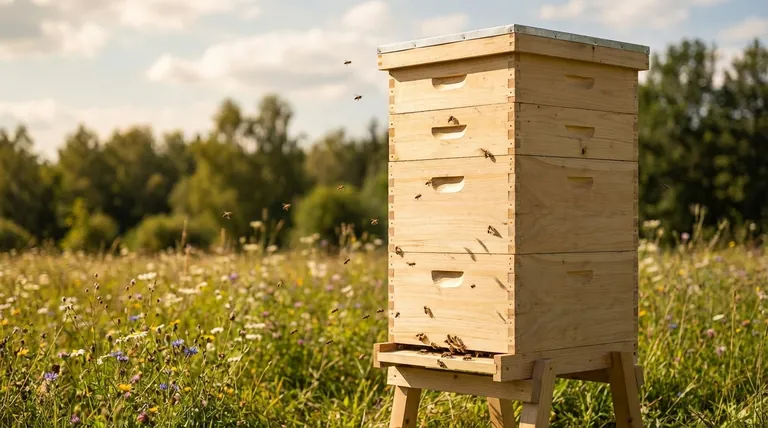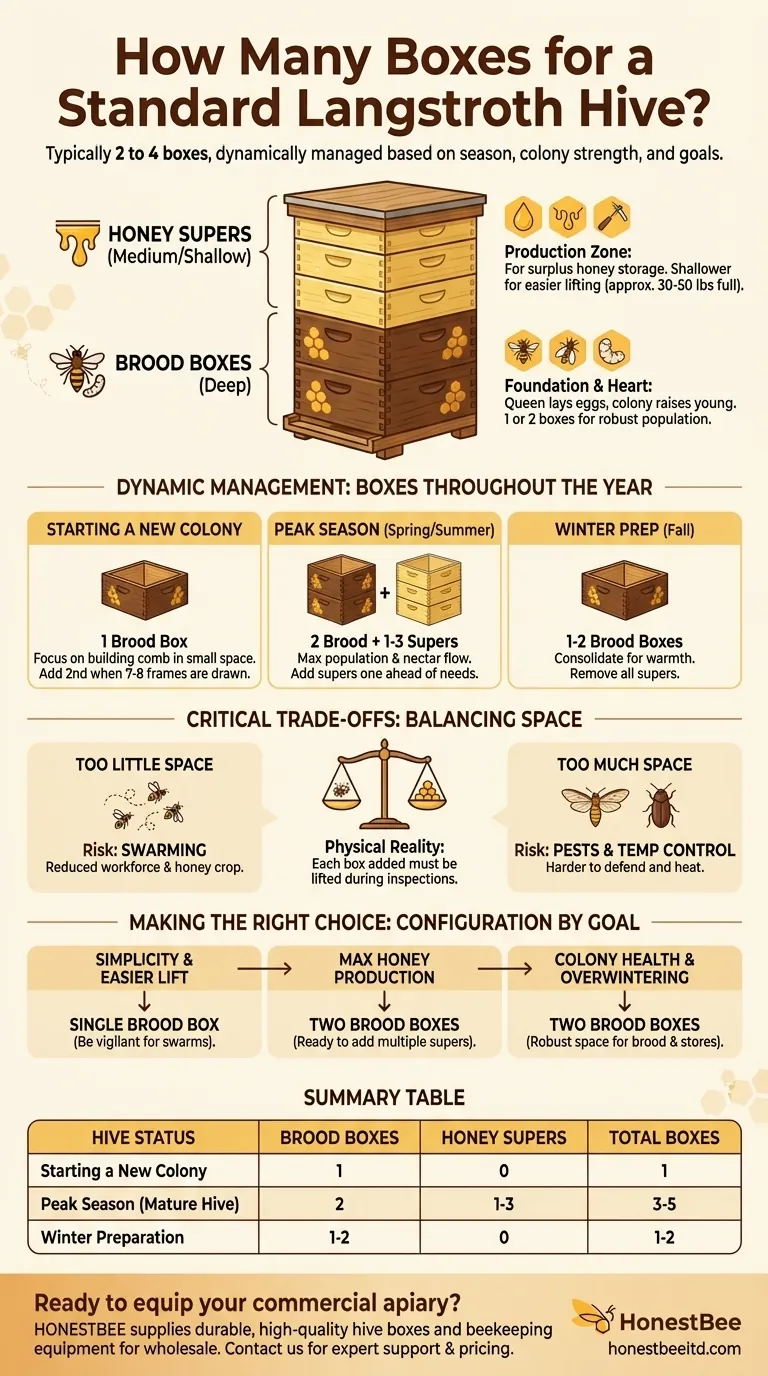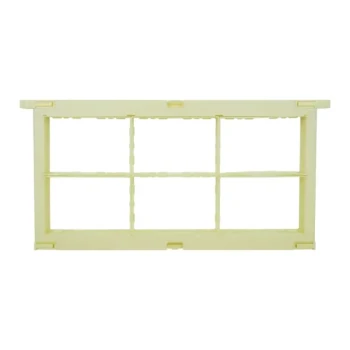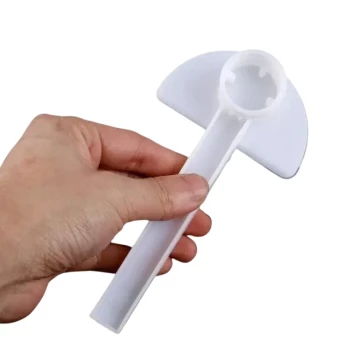For a standard Langstroth hive, you will typically need between two and four boxes, depending on the season, the strength of the colony, and your goals as a beekeeper. A common full-strength configuration consists of two deep boxes for the brood chamber and one or two shallower boxes (called "supers") on top for honey storage.
The number of boxes on a hive is not a static figure but a dynamic management tool. Your core task is to provide the colony with enough space to prevent swarming, but not so much space that they cannot effectively manage and defend it.
The Purpose of Each Box
A beehive is modular, with each box serving a distinct function. Understanding these roles is key to managing your hive's space effectively.
The Foundation: Brood Boxes
The bottom boxes are the brood chambers, the heart of the colony. This is where the queen lays her eggs and the colony raises its young bees. These are typically "deep" boxes.
A vigorous debate exists between using one or two brood boxes. A single brood box is simpler and lighter to inspect. However, a two-brood-box system provides more room for a prolific queen to lay and for the colony to store pollen and honey for its own use, creating a more robust population.
The Production Zone: Honey Supers
The boxes stacked on top of the brood chamber are called honey supers. These are intended for the bees to store surplus honey—the honey the beekeeper will eventually harvest.
These supers are often shallower ("medium" or "shallow" boxes) than the brood boxes. This is a practical decision, as a full deep box of honey can weigh over 50 pounds, making it extremely difficult to lift.
How Many Boxes to Use and When
The number of boxes changes throughout the year, reflecting the colony's natural cycle of growth and consolidation.
Starting a New Colony
A new colony, whether from a package or a "nuc," should start in a single brood box. This concentrates their initial efforts on building comb and raising brood in a small, defensible space. You will add a second box only when they have drawn out comb on 7 or 8 of the 10 frames.
Peak Season Management
For a mature hive during the spring and summer nectar flow, a common stack is two brood boxes and one to three honey supers. You add supers one at a time as the bees fill them, always aiming to stay one step ahead of their needs to prevent crowding.
Winter Preparation
As fall approaches and the population declines, the hive is typically consolidated down to one or two brood boxes. This smaller space helps the cluster of bees stay warm through the winter by reducing the volume they need to heat. Any honey supers are removed for harvesting.
Understanding the Critical Trade-offs
Managing hive space is a balancing act. Both too much and too little space create significant problems for the colony.
The Danger of Too Little Space
The primary consequence of a crowded hive is swarming. When the bees run out of room for brood and honey, they will instinctively raise a new queen and the old queen will leave with roughly half the colony's population. This drastically reduces your workforce and potential honey crop.
The Danger of Too Much Space
Giving a colony too much space before they are ready can be just as detrimental. The bees will struggle to patrol and defend the excess area, making the hive vulnerable to pests like wax moths and small hive beetles. An overly large cavity also makes it harder for the bees to maintain temperature and humidity.
The Physical Reality
Remember that every box you add must eventually be moved. A mature hive with four or five boxes requires the beekeeper to lift and move multiple boxes weighing 30-50 pounds each during an inspection. This physical demand is a real and important consideration in your management strategy.
Making the Right Choice for Your Hive
Your decision on hive configuration should be guided by observation and your primary beekeeping goal.
- If your primary focus is simplicity and easier lifting: A single-brood-box configuration may be best, but you must be vigilant about swarm management during peak season.
- If your primary focus is maximum honey production: A two-brood-box setup will support a larger population, which is essential for a large honey harvest, and you must be ready to add multiple supers.
- If your primary focus is colony health and overwintering success: A two-brood-box configuration generally provides a robust balance of space for brood and essential winter food stores.
Ultimately, learning to "read" the bees and provide space just before they need it is one of the most essential skills in beekeeping.

Summary Table:
| Hive Status | Brood Boxes | Honey Supers | Total Boxes |
|---|---|---|---|
| Starting a New Colony | 1 | 0 | 1 |
| Peak Season (Mature Hive) | 2 | 1-3 | 3-5 |
| Winter Preparation | 1-2 | 0 | 1-2 |
Ready to build or expand your apiary with the right equipment?
HONESTBEE supplies commercial apiaries and beekeeping equipment distributors with durable, high-quality hive boxes and beekeeping supplies through our wholesale-focused operations. Let us help you equip your hives for maximum health and productivity.
Contact HONESTBEE today for wholesale pricing and expert support!
Visual Guide

Related Products
- Langstroth Honey Bee Box Hive Boxes for Different Depths
- Australian Langstroth Beehive Boxes for Beekeeping Wholesales
- Langstroth Bee Hives Bee Keeping Box for Beginners Beekeeping
- HONESTBEE Professional Long Handled Hive Tool with Precision Cutting Blade
- Professional Insulated Plastic Bee Hives
People Also Ask
- How should hive boxes be aligned after reassembly? Ensure a Perfect Seal for Hive Health
- What is the purpose of the boxes in a Langstroth hive? A Guide to Modular Beekeeping Success
- What are the sizes available for Langstroth boxes? A Guide to 8-Frame vs. 10-Frame & Depths
- How deep is a medium bee box? Unlock the Key to a Versatile and Manageable Hive
- Why do you need two bee hives? Boost Your Apiary's Success with Smart Risk Management



















